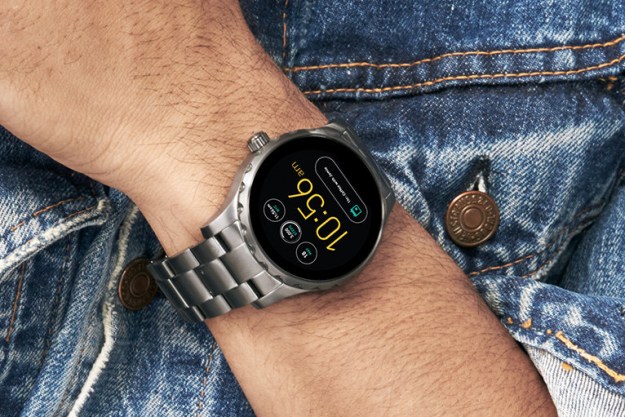
Smart jewelry and smart clothing are two categories that just keep picking up steam.
Meanwhile, fitness trackers are becoming more high tech, now that heart rate monitors and more accurate sensors are readily available at low prices.
However, wrist-bound wearables and smartglasses aren’t the only things we expect to see this year. Smart jewelry and smart clothing are two categories that just keep picking up steam. Although many will be fitness-focused, high-end fashion companies are jumping on the bandwagon, too.
Any way you shake it, wearables are here to stay, and they’re on the verge of becoming as ubiquitous and useful as your smartphone. Here are five big trends that we expect to see from wearables this year.
Your hipster glasses won’t just look smart — they’ll be smart
Google Glass may be summarily hated by every bar patron and non-techie in San Francisco, but there’s no denying that the search giant kicked off the smartglasses trend. Nonetheless, the difficulties Google Glass has faced haven’t deterred other manufacturers in the slightest. Sony, Vuzix, and others already have smartglasses in the works or on the market.

While most of these contraptions aren’t terribly subtle, smartglasses are starting to look a lot nicer. Google Glass now comes with stylish frame options, some of them from Diane von Furstenberg. Another pair of smart specs called the Jins Meme from Japan, look like normal glasses, but pack in loads of technology. The Meme can even monitor your alertness, and ensure you don’t fall asleep at the wheel. Jins will debut the glasses at CES in 2015.
We expect to see many more attractive and subtle smartglasses follow in Jins’ steps.
Tech companies will put a (smart) ring on it
Shortly after the wearable craze erupted, a bunch of small, crowd-funding projects for smart jewelry popped up on Indiegogo and Kickstarter. Projects like Ringly, Mota SmartRing, and Cuff zipped past their funding goals, proving that women may not be interested in bulky smartwatches, but they sure do love the idea of smart jewelry.

Recently, Intel picked up on the trend with its MICA smart bracelet, which packs smartwatch features into an attractive bangle. The snakeskin bracelet even has gold accents and semi-precious stones like pearls tacked on for style.
Now that Intel has gotten into the game, it seems all the more likely that other big-name tech companies will get to work on smart jewelry. Even if they don’t, small fish like Ringly, Mota, and Cuff will ensure that smart jewelry makes it big in 2015.
Your threads will support a web of sensors
Once upon a time, smart clothing was really just a euphemism for high-tech workout gear. While OMsignal, HexoSkin, and Sensoria will undoubtedly continue to push out smart fitness shirts, sports bras, and other apparel, more companies are ready to step into the arena with smart clothing for everyone else.
3D printed clothing is already making its way onto the runway, and big-name fashion brands like Ralph Lauren’s Polo and Victoria Secret are already strutting their stuff. We’ve already seen dresses embedded with LEDs that change color with your mood, fabric woven with fiber optics, and clothing that detects moisture in the air before it rains. While most of these high-tech fashion projects no doubt sound absurd to consumers, it’s a sign of the times. Smart clothing is on its way, and it will almost certainly be more inconspicuous and attractive in 2015 than it was this year. Hopefully it also becomes more useful.
You’ll know more about your body
Early fitness bands could barely get your step count right, but now the most high-end among them offer stats so accurate that Olympic athletes and their coaches use them to improve performance. Refinement of algorithms, improved sensors, and the addition of heart rate monitors are largely responsible for the shift.

Recent releases like the Intel Basis Peak smartwatch and Microsoft’s Band offer highly-detailed fitness and health metrics, proving that fitness bands are ready for prime time. We already know that Fitbit has plans for two more fitness bands with heart rate monitors onboard, and many others will also follow suit. In 2015, you’ll know more about your body than you ever wanted to know.
Additionally, low-end bands with the basics will cost less, so even your average Joe will have access to fitness metrics at all times. Sorry couch potatoes, you really don’t have an excuse anymore!
Models will show off wearables they’d actually wear
Up until this point, wearables have been aimed largely at men. Most companies mention women in passing, along with the claim that their smartwatch is “unisex.” Surprise! So far, gender-neutral wearables haven’t been a hit. However, that’s all about to change in 2015.
Not only are many of the fashion-focused, crowd-funded pieces of wearable tech arriving for sale online in 2015, but Apple’s first smartwatch is set to debut in the spring. Since the Apple Watch was first announced in September, it’s been to Paris Fashion week, posed on the cover of Vogue China, and earned several profiles in noted fashion magazines. Other manufacturers are sure to have noticed that Apple is targeting the most neglected demographic in the wearable market: women. Competitors like LG, Samsung, and Asus are sure to step up their game in 2015 with more attractive wearables, and maybe they’ll even make a watch or two for women.
There’s no doubt 2015 will be the year of the wearable. It should be interesting to see which form factors hit the mainstream and if manufacturers finally start going after both sexes.


